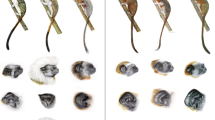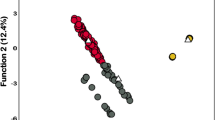Abstract
Black and white rhinoceroses are among the most charismatic megaherbivores and have become flagship species for international conservation. They are often subject to intense management that includes being compressed unnaturally in space and density. We present chromosomal and microsatellite evidence to substantiate the first recorded instance of interspecific hybridisation between them. The data suggest that the genetic integrity of the African rhinoceros species probably depends on differences in behavioural and ecological preferences that offer semipermeable reproductive isolation. We caution against the retention of both species in captive and other population situations where disruption of species-specific behaviour patterns may result if there is an unnatural composition in terms of age and sex, and where access to conspecific mates is restricted or absent.
Similar content being viewed by others
References
SM Brown BA Houlden (1999) ArticleTitleIsolation and characterization of microsatellite markers in the black rhinoceros (Diceros bicornis) Mol Ecol. 8 1559–1561 Occurrence Handle10617348 Occurrence Handle1:CAS:528:DyaK1MXntlaku7w%3D
J Cunningham EH Harley C O’Ryan (1999) ArticleTitleIsolation and characterisation of microsatellite loci in black rhinoceros (Diceros bicornis) Electrophoresis 20 1778–1780 Occurrence Handle10435448 Occurrence Handle1:CAS:528:DyaK1MXkvVyhtbw%3D
RH Emslie PM Brooks (1999) African Rhino: Status Survey and Conservation Action Plan IUCN/SSC African Rhino Specialist Group IUCN Gland Switzerland and Cambridge, UK
Foose T (1993) Global management of rhinos. In Proceedings of a Conference: Rhinoceros Biology and Conservation (ed. Ryder OA), pp 32–47. Zoological Society of San Diego.
AP Gray (1971) Mammalian hybrids Commonwealth Agricultural Bureaux Slough England
JS Haldane (1922) ArticleTitleSex ratio and unisexual sterility in hybrid animals J. Genet. 12 101–109 Occurrence Handle10.1007/BF02983075
ML Houck OA Ryder J Vahala RA Kock JE Oosterhuis (1994) ArticleTitleDiploid chromosome number and chromosomal variation in the White rhinoceros (Ceratotherium simum) J. Hered. 85 30–34 Occurrence Handle8120356 Occurrence Handle1:STN:280:ByuC28rktlc%3D
Leader-Williams N (1993) Theory and pragmatism in the conservation of rhinos. In Proceedings of a Conference: Rhinoceros Biology and Conservation (ed. Ryder OA), pp 69–81. Zoological Society of San Diego.
N Leader-Williams RA Brett M Brookes I Craig RF duToit RH Emslie MH Knight MR Stanley-Price C Stockil (1997) ArticleTitleA scheme for differentiating and defining the different situations under which live rhinos are conserved Pachyderm 23 24–28
Lindemann H (1982) African rhinoceroses in captivity. Thesis, University of Copenhagen.
Owen-Smith RN (1988) Megaherbivores–The Influence of Very Large Body Size on Ecology. Cambridge University Press.
D Paetkau LP Waits PL Clarkson L Craighead C Strobeck (1997) ArticleTitleAn empirical evaluation of genetic distance statistics using microsatellite data from bear (Ursidae) populations Genetics 147 1943–1957 Occurrence Handle9409849 Occurrence Handle1:STN:280:DyaK1c%2Fnt1GjtQ%3D%3D
M Seabright (1971) ArticleTitleA rapid banding technique for human chromosome Lancet 2 971–972 Occurrence Handle10.1016/S0140-6736(71)90287-X Occurrence Handle1:STN:280:CS2D2M7lsVI%3D Occurrence Handle4107917
R H N Smithers (1983) The Mammals of the Southern African Subregion University of Pretoria Pretoria
Stanley Price MR (1993) What will it take to save the rhino. In Proceedings of A Conference: Rhinoceros Biology and Conservation (ed. Ryder OA), pp. 48–68. Zoological Society of San Diego.
A Sumner (1972) ArticleTitleA simple technique for demonstrating centromeric heterochromatin Exp. Cell Res. 75 304–306 Occurrence Handle4117921 Occurrence Handle1:STN:280:CSyD2cjltFI%3D
C Tougard T Delefosse C Hanni C Montgelard (2001) ArticleTitlePhylogenetic relationships of the five extant rhinoceros species (Rhinocerotidae, Perissodactyla) based on mitochondrial cytochrome b and 12S rRNA genes Mol. Phylogenet. Evol. 19 34–44 Occurrence Handle11286489 Occurrence Handle1:CAS:528:DC%2BD3MXitlOjtbw%3D
V Trifonov F Yang MA Ferguson-Smith TJ Robinson (2003) ArticleTitleChromosome painting in the Perissodactyla: Delimitation of homologous regions in Burchell’s zebra (Equus burchelli) and the White (Ceratotherium simum) and Black Rhinoceros (Diceros bicornis) Cytogenet. Genome Res. 103 104–110 Occurrence Handle15004472 Occurrence Handle1:STN:280:DC%2BD2c7htlKkug%3D%3D
F Yang B Fu PCM O’Brien TJ Robinson OA Ryder MA Ferguson-Smith (2003) ArticleTitleKaryotypic relationships of horses and zebras: Results of cross-species chromosome painting Cytogenet Genome Res. 102 235–243 Occurrence Handle14970709 Occurrence Handle1:STN:280:DC%2BD2c%2FotVKkuw%3D%3D
Author information
Authors and Affiliations
Corresponding author
Rights and permissions
About this article
Cite this article
Robinson, T., Trifonov, V., Espie, I. et al. Interspecific hybridisation in rhinoceroses: Confirmation of a Black × White rhinoceros hybrid by karyotype, fluorescence in situ hybridisation (FISH) and microsatellite analysis. Conserv Genet 6, 141–145 (2005). https://doi.org/10.1007/s10592-004-7750-9
Received:
Accepted:
Issue Date:
DOI: https://doi.org/10.1007/s10592-004-7750-9




